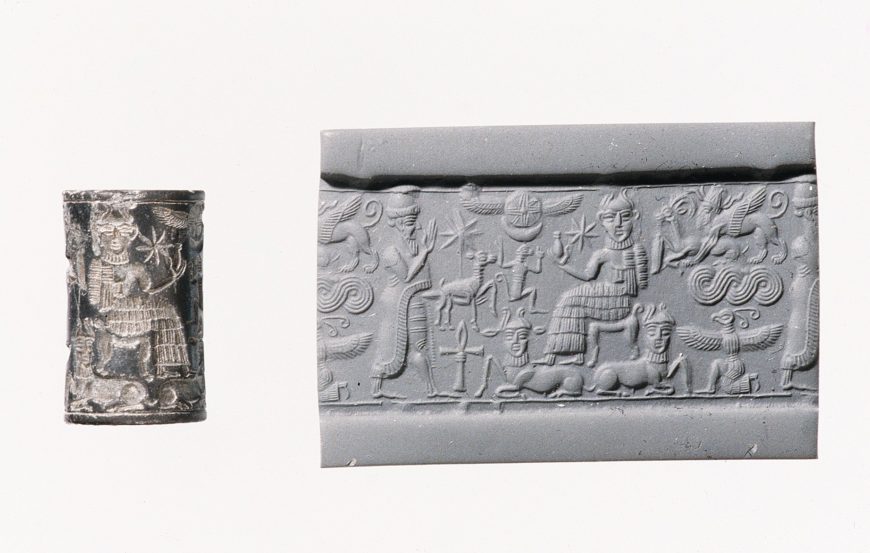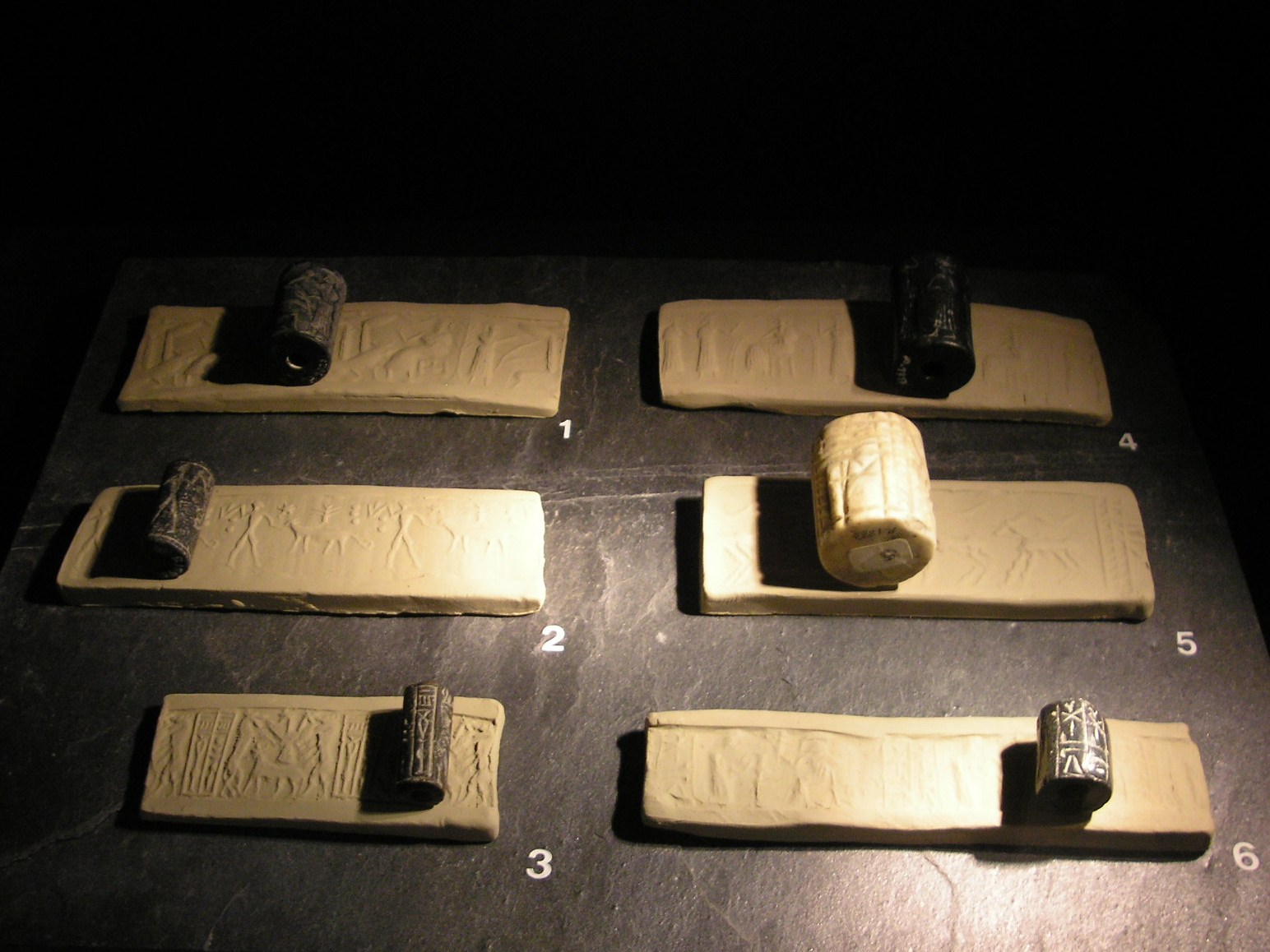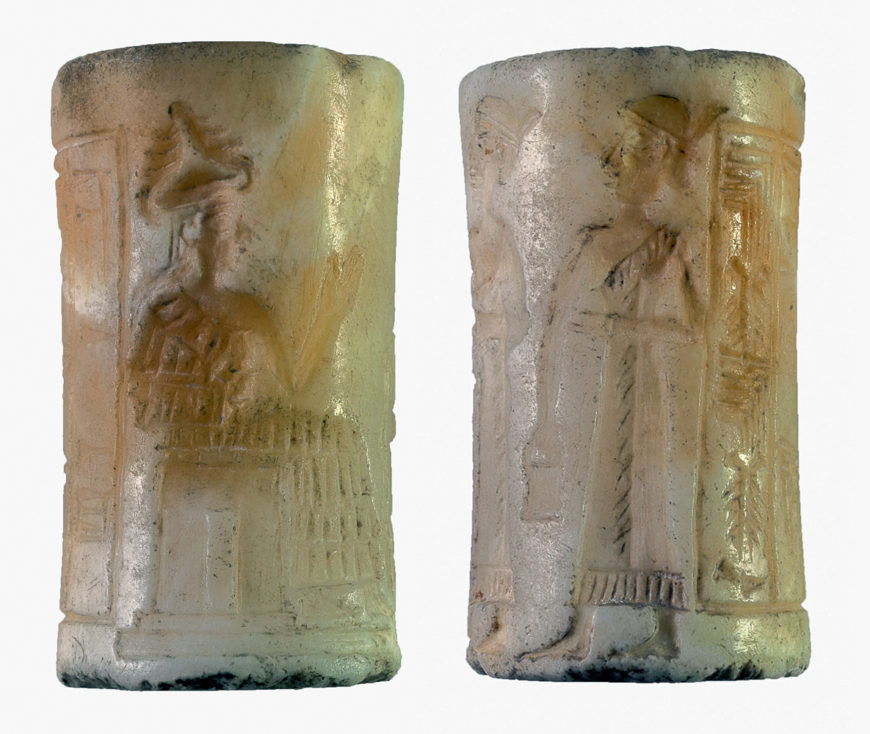
Cylinder Seal (with modern impression), royal worshipper before a god on a throne with bull’s legs; human-headed bulls below, c. 1820–1730 B.C.E., hematite, 2 cm tall (The Metropolitan Museum of Art, New York)
Signed with a cylinder seal
Cuneiform was used for official accounting, governmental and theological pronouncements and a wide range of correspondence. Nearly all of these documents required a formal “signature,” the impression of a cylinder seal.
A cylinder seal is a small pierced object, like a long round bead, carved in reverse (intaglio) and hung on strings of fiber or leather. These often beautiful objects were ubiquitous in the Ancient Near East and remain a unique record of individuals from this era. Each seal was owned by one person and was used and held by them in particularly intimate ways, such as strung on a necklace or bracelet.

Seals with modern impression strips. (1) Cylinder seal, winged gate of heaven on a bull, tree of life, a servant holds the ropes of the gate of heaven, Akkad period, c. 2200 B.C.E.; (2) Cylinder seal, Gilgamesh searching for the tree of immortality, which is guarded by a dragon. The holes are dens of dangerous animals, Assyrian, c. 2000 B.C.E.; (3) Cylinder seal, Babylonian copy of ancient Sumerian motifs and (misunderstood) ancient Sumerian characters, Babylon, mid-1st millennium B.C.E., steatite (private collection); (4) Cylinder seal, worship before the god “Ea”, fertilizing water, Babylon, Akkad period, c. 2300 B.C.E., steatite; (5) Cylinder seal, the Holy Flock in front of the Temple, Babylon, Djemdet Nasr period, c. 2800 B.C.E., limestone; and (6) Cylinder seal, Babylon, c. 3000 B.C.E, black steatite (Collection Basler Papiermühle, Basel; photo: Gryffindor)
When a signature was required, the seal was taken out and rolled on the pliable clay document, leaving behind the positive impression of the reverse images carved into it. However, some seals were valued not for the impression they made, but instead, for the magic they were thought to possess or for their beauty.
The first use of cylinder seals in the Ancient Near East dates to earlier than the invention of cuneiform, to the Late Neolithic period (7600–6000 B.C.E.) in Syria. However, what is most remarkable about cylinder seals is their scale and the beauty of the semi-precious stones from which they were carved. The images and inscriptions on these stones can be measured in millimeters and feature incredible detail.
The stones from which the cylinder seals were carved include agate, chalcedony, lapis lazuli, steatite, limestone, marble, quartz, serpentine, hematite, and jasper; for the most distinguished there were seals of gold and silver. To study Ancient Near Eastern cylinder seals is to enter a uniquely beautiful, personal and detailed miniature universe of the remote past, but one which was directly connected to a vast array of individual actions, both mundane and momentous.

Cylinder seal, owned by a woman named Šaša, Akkadian, calcite, 39 x 22 mm, from Khafajeh, Iraq (Institute for the Study of Ancient Cultures Museum, University of Chicago)
Why cylinder seals are interesting
Art historians are particularly interested in cylinder seals for at least two reasons. First, it is believed that the images carved on seals accurately reflect the pervading artistic styles of the day and the particular region of their use. In other words, each seal is a small time capsule of what sorts of motifs and styles were popular during the lifetime of the owner. These seals, which survive in great numbers, offer important information to understand the developing artistic styles of the Ancient Near East.
The second reason why art historians are interested in cylinder seals is because of the iconography (the study of the content of a work of art). Each character, gesture and decorative element can be “read” and reflected back on the owner of the seal, revealing his or her social rank and even sometimes the name of the owner. Although the same iconography found on seals can be found on carved stelae, terra cotta plaques, wall reliefs, and paintings, its most complete compendium exists on the thousands of seals which have survived from antiquity.

